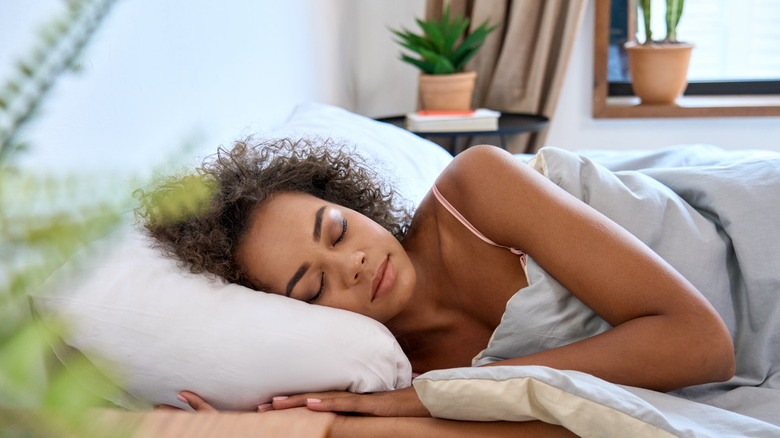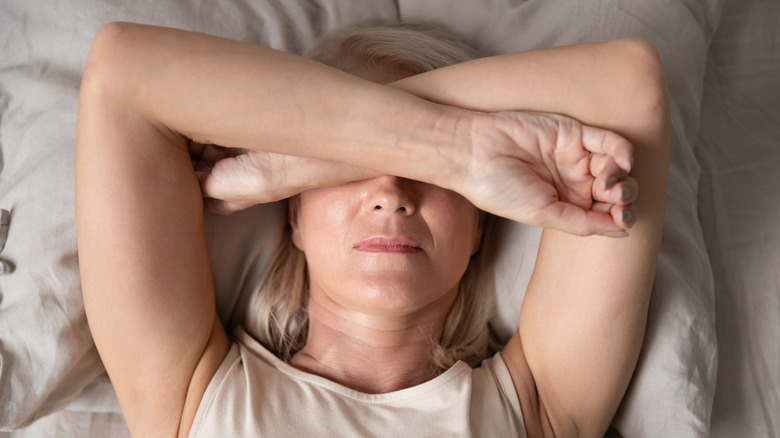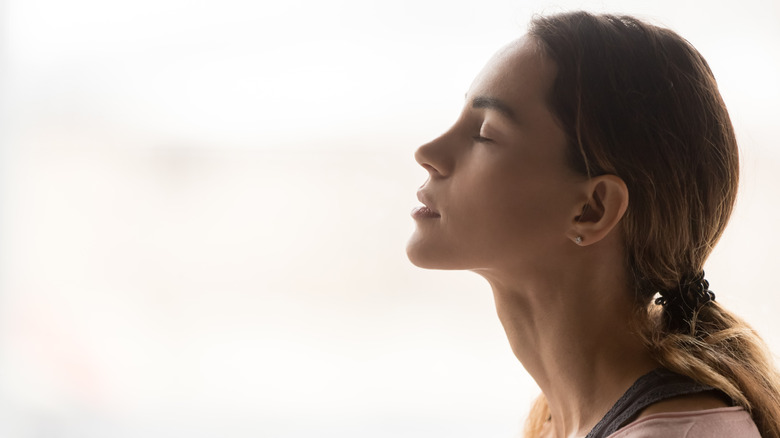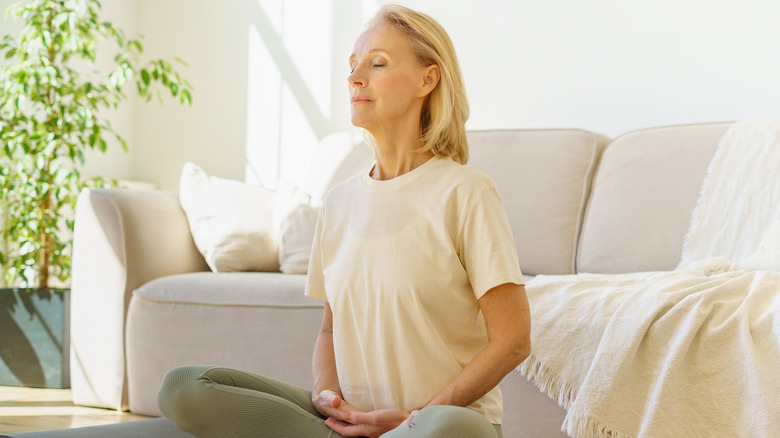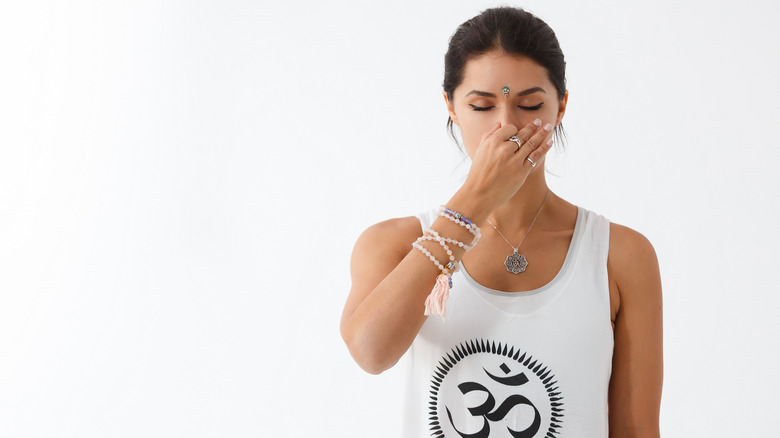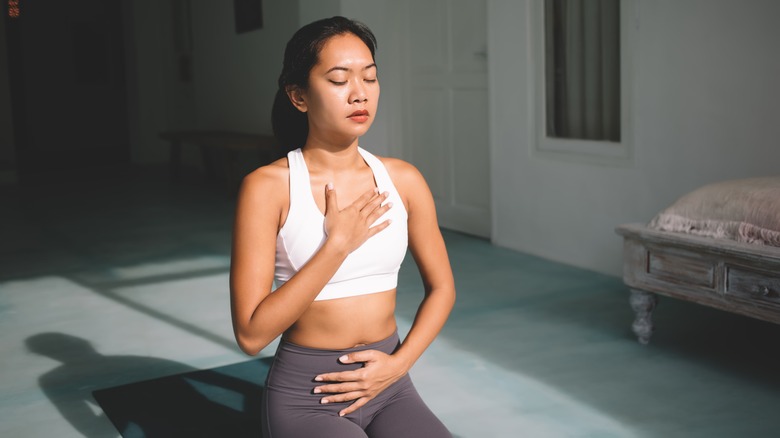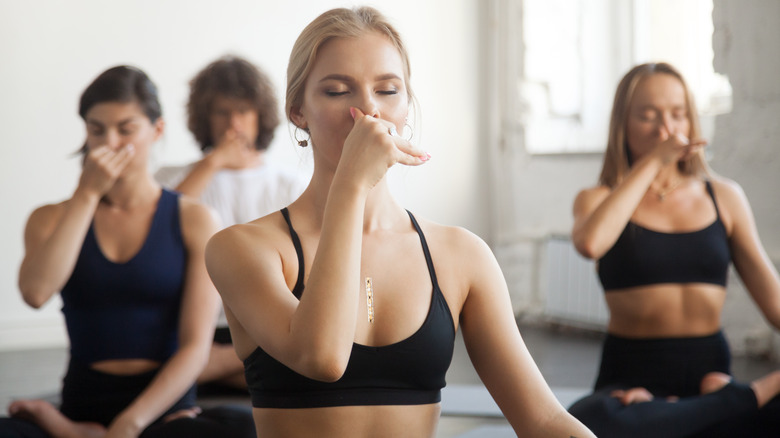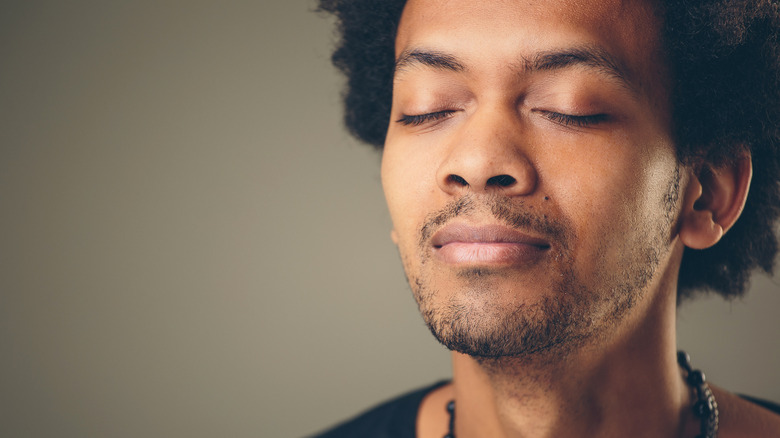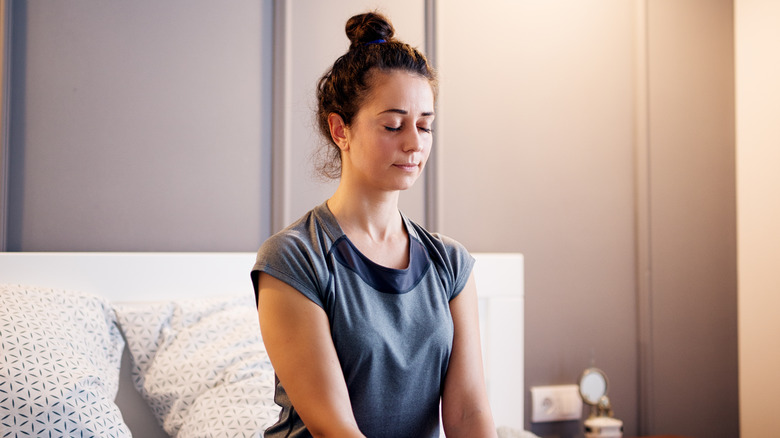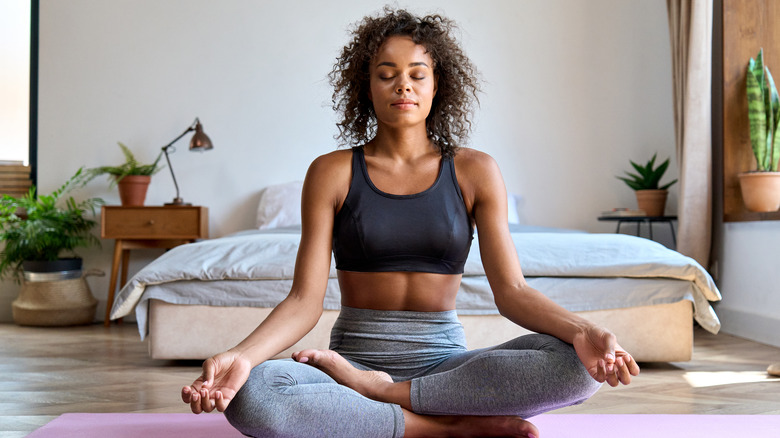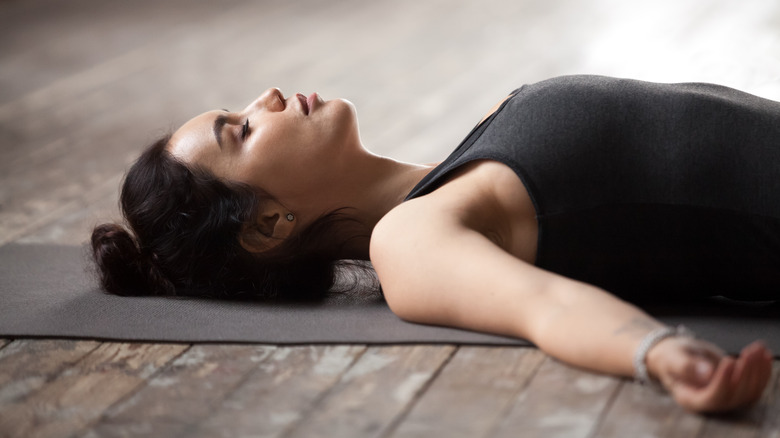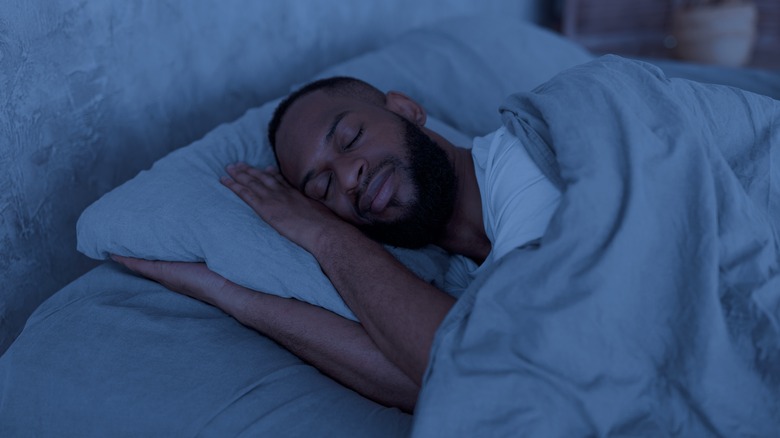Breathing Techniques That Can Help You Get To Sleep Fast
We may receive a commission on purchases made from links.
Sleep deficiency has been declared a global public health epidemic (via Healthcare). According to the American Sleep Apnea Association, 50 to 70 million Americans have trouble sleeping, and the Centers for Disease Control and Prevention (CDC) reports that one in three adults regularly gets insufficient sleep.
Sleep deficiency leads to a host of problems; in the short-term, it can affect your mood, alertness and reaction time, memory, and your ability to learn new things.
In the long-term, sleep deficiency has been linked to myriad chronic health conditions, including obesity, high blood pressure, diabetes, heart disease, stroke, and mental health problems. If you're not getting enough sleep, it's crucial for your health and well-being to find a way to get more.
One of those ways is to get to sleep earlier. This is easier said than done. Many people have trouble unwinding at the end of the day and find themselves wide-eyed and staring at the ceiling when they should be asleep. If you struggle to drift off when your head hits the pillow, the good news is that you have lots of options (besides sleeping pills) to make it easier. Doing some simple breathing exercises before bed can help calm the mind and body and help you fall asleep faster (via the Sleep Foundation).
Why you can't fall asleep
The first step to falling asleep faster is to determine why you can't fall asleep. Are you stressed about work, relationships, or financial problems? Do you drink caffeine too close to bedtime? These are a few common reasons for difficulty drifting off (via Risk Management and Healthcare Policy and Baylor College of Medicine). Other biggies are using electronics shortly before bedtime, watching TV in bed, and having a bedroom that isn't conducive to sleep — either because it's too warm, not dark enough, or your bed is uncomfortable (via CDC).
Many health conditions can make falling asleep difficult. According to the Mayo Clinic, these include diabetes, asthma, heart disease, overactive thyroid, Parkinson's disease, cancer, gastroesophageal reflux disease (GERD), chronic pain, and cancer. Mental health disorders, such as anxiety and post-traumatic stress disorder, can make it difficult to drift off. Diagnosed sleep disorders, including sleep apnea and restless leg syndrome, are obvious culprits. And medications, including some depression, asthma, and heart disease medications, can also interfere with getting to sleep quickly.
Whatever the cause of your late nights, using relaxation techniques such as breathing exercises can help. Keep in mind, it's not a substitute for medical care in the case of a health condition, but it can be an effective adjunct treatment.
How breathing techniques can help
Have you noticed how taking a deep breath when you're stressed out can make you feel more calm? Breathing in a slow and controlled manner is a powerful technique for reducing physical and mental arousal. And its effects have been scientifically documented many times over.
In a 2020 study in Frontiers in Psychiatry, Yale researchers examined the effect of three different interventions used to mediate stress, depression, and anxiety in 131 university students. The three interventions included a mindfulness-based stress reduction program, an emotional intelligence program, and a breathing meditation-based program called SKY Campus Happiness. At the end of the eight-week trial, the greatest improvements were seen in the SKY program participants. Researchers concluded that modulation of respiration can impact mental health conditions, reduce stress, improve cognitive function, and enhance emotional regulation and psychological well-being.
So deep breathing can reduce stress and improve your mental health, which is great if a racing mind is keeping you up at night. Deep breathing also has physiological effects that help relax the body and mind. According to a 2018 Frontiers in Psychiatry article, deep breathing can help relax the sympathetic nervous system, the part of your nervous system that remains vigilant and ready to respond to stressful situations (via the Cleveland Clinic). At the same time, it can stimulate the parasympathetic nervous system which relaxes the body after stressful or dangerous situations, explains the Cleveland Clinic. Combined, these two actions can get the body into a restful state ready for sleep.
4-7-8 breathing
The 4-7-8 Breathing Exercise was developed by Dr. Andrew Weil (via Healthline). Also called the Relaxing Breath, it's a very simple practice that can be done anywhere at any time, especially when you're lying in bed staring at the ceiling. One of the reasons it's powerful is because it forces you to focus on what you're doing in the moment — called mindfulness (via Mindful). This can distract you from racing thoughts or from focusing on the fact that you can't get to sleep (which is often enough to keep you awake). It involves controlling the rhythm of your breath and counting — a little like counting sheep.
Here's how to do it (via Dr. Weil): Rest the tip of your tongue behind your front teeth on the roof of your mouth. Keep your tongue in this position throughout the practice. Allow your lips to part and take a full exhale. As you do this, the air will make a whooshing sound as it passes your tongue and lips. Close your lips, and slowly and quietly inhale through your nose for a count of four. At the top, hold your breath for a slow count of seven, then exhale for a slow count of eight, making the same whooshing sound you did in the beginning. Repeat this breath cycle three more times.
Dr. Weil advises that the 4-7-8 count is important. If you're finding it difficult to hold your breath for seven seconds, speed up your count but keep the ratio of each breath the same.
Alternate nostril breathing
If you practice yoga, you might recognize this breathing exercise. Alternate nostril breathing is a form of pranayama, a breath regulation practice originating in ancient India (via Yoga Journal). It involves pinching one nostril and then the other as you breathe in and out in a slow and controlled manner. Like 4-7-8 breathing it forces you to focus on what you are doing in the moment, incorporating the element of mindful meditation.
This breathing exercise is best done in a seated position. However, once you've learned the technique, you can do it lying down if you feel that puts you in a more relaxed state. Here's how to do it (via the Sleep Foundation): Sit up tall on your bed with your legs crossed or on a chair. Place your thumb and index finger of your right hand on either side of your nose. Press your right nostril with your right thumb, blocking the airway, as you inhale slowly through your left nostril for a count of six. Then, press your left nostril with your index finger and release your thumb from your right nostril. Exhale slowly through your right nostril for a count of six. Repeat this cycle several times.
Diaphragmatic breathing
Diaphragmatic breathing, or belly breathing, involves moving the stomach rather than the chest with each inhale and exhale. As with other breathing exercises, focusing on the breath helps distract and quiet your mind. Along with activating the parasympathetic nervous system, it also helps lower your blood pressure and heart rate, release muscle tension, and reduce stress hormones. In addition to promoting sleep, deep belly breathing can be used for a wide variety of mental and physical health conditions. According to University of Michigan Health, it has specific benefits for gastrointestinal upset because it gently massages the intestines and stomach to help relieve abdominal pain, bloating, and constipation.
Here's how to do it: Sit or lie in a comfortable position and close your eyes. Place one hand on your belly and one hand on your chest. The hand on your belly should be the hand that's moving during the exercise, and the top hand should remain relatively still. Inhale for a slow count of four, and notice your belly rising as you do so. Hold for a count of two, then exhale very slowly through your mouth for a count of six. Keep your lips relaxed as you exhale. Repeat for five to 15 minutes.
Bhramari pranayama
Also called Humming Bee Breath, Bhramari pranayama involves humming, or buzzing, like a bee. It may sound silly, but it's highly effective at relaxing the sympathetic nervous system and stimulating the parasympathetic nervous system, according to a 2016 study in the Journal of Clinical and Diagnostic Research. There are several types of bhramari pranayama, but there's no need to practice all of them (per Yoga International). Learn the basic method so you can practice when you're having trouble getting to sleep.
Here's how to do it: Try this practice seated first, either in your bed, on the floor, or in a chair. If you're sitting on the floor or in your bed, Yoga International suggests using a pillow to prop up your pelvis so that your thighs are angling down. If you're sitting in a chair, slide forward to the edge of the seat so that your thighs are angling down. Throughout the practice, keep your facial muscles loose, your jaw relaxed, your lips closed very slightly with your upper and lower jaw separated slightly.
Close your eyes and inhale fully. As you exhale slowly, make a humming sound in the back of your throat. It should be low to medium in pitch, never too loud or forced. Observe how the humming creates vibrations throughout your head — in your tongue, teeth, sinuses, and even your brain. Repeat five more times.
Buteyko breathing
The Buteyko Breathing method was developed in the 1950s by a Ukrainian doctor named Konstantin Buteyko, according to Hadas Golan, speech pathologist and registered Buteyko educator, in an interview with the Boston Medical Center. Buteyko observed that breathing exercises helped improve his patients' symptoms and attenuated the disease process. Using himself as a test subject, Buteyko used breathing exercises to successfully control his high blood pressure, and later applied it to improving other health conditions.
Buteyko's method can also be effective for insomnia, according to Buteyko Clinic International. Similar to other breathing exercises, it involves controlling the inhalation and exhalation, which both relaxes the parasympathetic nervous system and forces the mind to focus on the breath.
Here's how to do it (via Healthline): There are two parts to the Buteyko method — the control pause and the maximum pause. Sit with your spine erect and breathe normally for a few minutes. After an exhale, use your thumb and index finger to close your nostrils. Hold your breath until you feel a marked urge to breathe — the control pause — then release your nostrils and inhale. Continue to breathe normally for a minimum of 10 seconds, then repeat several times. Next, do the same thing, but hold your breath as long as you can — the maximum pause. Repeat several times.
Box breathing
Box breathing is similar to 4-7-8 breathing, but it uses an equal ratio of inhaling, exhaling, and holding the breath. Also called "square breathing" or four-square breathing," it's a four-step breathing practice used to control the breath and calm the mind and body. As reported in TIME, this is the method former Navy SEAL and author of the book "Kokoro Yoga" Mark Divine used to calm and focus himself in combat.
Here's how to do it: Lie down or sit in a comfortable position. Exhale all the air from your lungs, and hold your breath for a count of four. Divine explains that you should avoid tensing and creating back pressure at this point. Rather, you should maintain the posture of inhaling — open and expansive — even though you are exhaling. After holding for four counts, inhale for four counts and this time hold your breath at the top. Exhale again for a count of four, hold for four, then inhale again for four and hold for four at the top. Repeat this cycle for at least five minutes.
How to incorporate breathing techniques into your bedtime routine
Do you have a bedtime routine? A series of things you do every night to prepare you for a restful night's sleep? If you're like most people, probably not. But creating a bedtime routine is key for relaxing your body and mind before sleep, according to the Sleep Foundation. These things should be performed in the same order about 30 minutes to one hour before bed each night. This routine not only relaxes you, but it trains your body to know when it's time to sleep.
Some common things to include in a bedtime routine include drinking chamomile tea, having a warm bath, spending some time journaling, or gentle stretching. Breathwork is also a great addition to your bedtime routine. You can do your exercises seated with the lights on or dimmed, or you can turn off the lights and do your exercises lying down. Either way, be sure to relax and focus on the measured inhales and exhales. Just like with meditation, if you get distracted by a thought, bring your mind back to the breathing (via CSUSM).
Mindfulness meditation
Maybe breathing isn't working for you, or you want to add other techniques into your bedtime routine. You've got lots of options. Mindfulness meditation is similar to breathing exercises in many ways. According to the Mayo Clinic, mindfulness is a practice in which you focus on your feelings and sensations in the present moment. An April 2015 study in JAMA Internal Medicine found that mindfulness meditation training was more helpful than a sleep hygiene education intervention in improving sleep quality in older adults with moderate sleep disturbances.
How to do it: Unlike the breathing exercises, there is no specific pattern to your breath during mindfulness meditation. Inhale and exhale through your nose and focus on the sounds and sensations of each breath. If you find thoughts about work or what you're going to have for breakfast intrude, just bring your mind back to your breath. Practice for 10 to 20 minutes (via The Harvard Gazette). This is an easy practice to do once you turn off the lights, and you can do it any time of day to find a sense of peace and tranquility.
Progressive muscle relaxation
When your muscles are relaxed it's easier for your mind to relax. That's the basis of progressive muscle relaxation (via the Sleep Foundation). This exercise involves tensing and relaxing 16 muscle groups one at a time. A 2020 study in Complementary Therapies in Clinical Practice found that progressive muscle relaxation was highly effective at reducing anxiety and improving sleep quality in a group of COVID-19 patients when compared to a control group. And a 2017 study in Sleep Breathing Physiology and Disorders found that progressive muscle relaxation training had significant impacts on sleep quality in a group of patients who had undergone pulmonary resection.
Here's how to do it (via Anxiety Canada): Lie on your back and close your eyes. Starting with your feet, flex one ankle and curl your toes to contract the muscles on the top and bottom of your foot. Hold this contraction for five seconds, then completely release the muscle. Feel the sensation of the tension leaving the muscle. Do one foot and then the other. After 15 seconds, move to the next muscle group, the calf muscles. Tense each calf for five seconds by pulling your toes toward you, then relax for 15 seconds. Next, do your entire leg, contracting your thigh, calf, and foot muscles all at once. Next, do your hands by clenching your fists, and arms by contracting your biceps. Your buttocks are next, followed by your stomach, chest, neck and shoulders, mouth, eyes, and forehead.
Guided imagery
What if you could imagine yourself peacefully sleeping and then actually drift off to sleep? With guided imagery you can. By visualizing peaceful, restful places and situations you can encourage your mind and body to relax into sleep. It sounds too good to be true, but it's not. A 2017 study in Critical Care Nurse found that guided imagery reduced pain and anxiety and improved sleep in patients in a progressive care unit, and worked just as well as clinical massage.
Here's how to do it (via Healthline): Lie down in a comfortable position and close your eyes. Inhale and exhale deeply for several rounds. Maintain this deep breathing throughout the exercise. With your eyes closed, imagine yourself in a place that brings you peace, whether that's the beach, mountains, or a quiet library. Conjure up all the details of the environment — the sounds, smells, and sensations you feel in this place. Imagine yourself walking through the scene, taking in all the details of your location as you wander. Continue to do this for 15 minutes, then open your eyes.
You can also listen to a guided imagery meditation online; however, for good sleep hygiene, you should avoid looking at phone, computer, or TV screens for at least an hour before bed (via the Cleveland Clinic).
Practice good sleep hygiene
Sleep hygiene is a collection of habits that can improve your sleep duration and quality. This includes your bedtime routine, as well as your sleeping environment. According to the CDC, you should try to go to bed and wake up at the same time every day, even on the weekends. This establishes your body's sleep-wake cycle (via the Mayo Clinic).
Make your bedroom conducive to sleep. It should be dark, quiet, cool, and comfortable. Avoid looking at television, phone, or computer screens at least one hour before bed. The blue light from your phone is stimulating like daylight and can make you feel more alert, which is not what you want before bed. It's also easy to get distracted scrolling on social media when you should be sleeping.
Be mindful of what you eat and drink in the hours before bedtime. You should avoid caffeine for at least six hours before sleep, according to a 2013 study in Journal of Clinical Sleep Medicine. You should also avoid large meals and alcohol, both of which can interrupt your sleep. Alcohol might help you get to sleep faster, but it can make it harder to get deep sleep and to stay asleep (via the Cleveland Clinic).
In addition, if you nap during the day, don't do so within eight hours of bedtime and keep naps to 30 minutes or less (via the Sleep Foundation). Engaging in regular physical activity can also help you fall asleep more easily.

